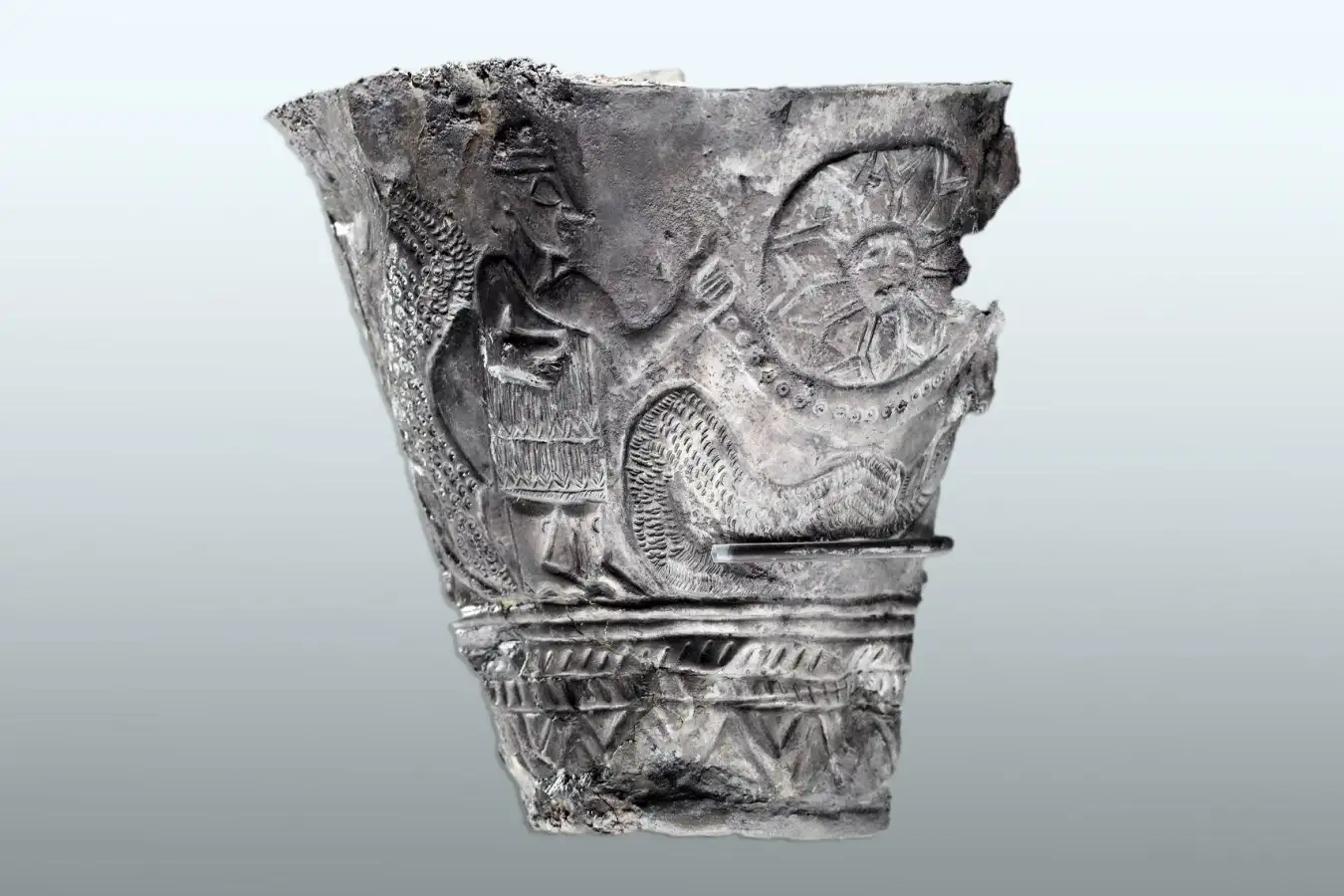
The ˁAin Samiya silver goblet
The Israel Museum, Jerusalem/Ardon Bar Hama
The artwork on a 4300-year-old silver goblet unearthed in the Palestinian West Bank appears to show the universe forming out of primordial chaos – making it the oldest known visual representation of a creation myth.
“I think it’s an ingenious design,” says Eberhard Zangger at the Luwian Studies Foundation, a non-profit based in Switzerland. “With very few lines, it tells a very complex story.”
The ˁAin Samiya goblet stands about 8 centimetres tall. It was found 55 years ago in an ancient tomb a few miles to the north-east of Ramallah at the western tip of the Fertile Crescent – a region where early civilisations flourished.
There appear to be two scenes depicted on the goblet. In the first, a large snake rears up and faces a chimera with a human torso and the legs of an animal, who stands over a small flower-like circle. In the second, a snake lies on the ground beneath a much larger flower-like circle with a smiling face. The circle is being held up, probably by two fully humanoid figures – although only one is visible today because the goblet is broken.
Archaeologists in the 1970s suggested the two scenes came from Enūma Eliš, a Babylonian creation myth in which a primordial entity named Tiamat is defeated in battle by the god Marduk, who then turns Tiamat’s body into the heavens and Earth. But, Zangger says, other researchers have pointed out flaws with this idea. Not only is there no battle scene on the goblet, but it was also made about 1000 years before Enūma Eliš was first written down.
Because of this, other researchers have suggested alternative interpretations – for instance, that the goblet is a symbolic representation of the birth of the new year and the death of the old one.
But Zangger and his colleagues – Daniel Sarlo, an independent researcher in Toronto, and Fabienne Haas Dantes at the University of Zurich, Switzerland – think the original interpretation was nearer to the mark. They argue that the scenes do show the formation of the world and cosmos, but that they come from a creation story far older than Enūma Eliš.
The images engraved on the goblet depict deities, snakes and the sun
Israel Museum, Jerusalem/Florika Weiner
In the first scene, according to Zangger’s team, there is chaos. The chimera represents a weak god, fused with the animals. Beneath its legs, the small flower-like circle represents a powerless sun. Ruling over all of this chaos is a monstrous snake. But in the second scene, order has emerged peacefully from the chaos. The gods have been separated from the animals, becoming powerful humanoid characters. They hold the equally powerful sun aloft in a “celestial boat”, indicating that the heavens have now been separated from Earth. The monstrous serpent of chaos, defeated, lies beneath the sun.
Zangger points out that there are cuneiform texts from elsewhere in the Fertile Crescent that are similar in age to the goblet and that describe how the gods separated the heavens from Earth. As such, we know that the inhabitants of the region had developed stories about the creation of the world by the time the goblet was fashioned. “But the incredible thing about the goblet is that we now have a picture of what they imagined this creation to have looked like,” he says.
Jan Lisman, an independent researcher based in the Netherlands, is unconvinced by the interpretation. “What may be depicted is the daily movement of the sun,” he says. “But definitely not ‘origin’ or ‘chaos’.”
Silvia Schroer at the University of Bern in Switzerland is more willing to accept the possibility that the goblet shows the creation of the world. But she sees problems with another aspect of the new analysis.
Zangger and his colleagues say that some of the images on the ˁAin Samiya goblet – such as a monstrous snake – appear in ancient cosmological stories from across the Fertile Crescent and nearby regions. They argue that this hints at deep connections among all of these creation myths, suggesting they may all draw from a single, even older myth. In line with this, they point out that a celestial boat similar to that on the goblet is carved onto a pillar at the 11,500-year-old site of Göbekli Tepe in what is now Turkey, to the north-west of the Fertile Crescent. “That’s 7000 years earlier than the goblet,” says Zangger.
But Schroer thinks it’s far too speculative to suggest all of the region’s creation stories are deeply connected like this. “Even if there are similarities, there is not always a demonstrable influence,” she says.
JEOL – Journal of the Ancient Near Eastern Society “Ex Oriente Luxˮ DOI: in press
Scientific pioneers of the ancient world, Cairo and Alexandria: Egypt
Embark on an unforgettable journey through Egypt’s two most iconic cities, Cairo and Alexandria, where ancient history meets modern charm.
Topics:
Source link : https://www.newscientist.com/article/2504102-ancient-silver-goblet-preserves-oldest-known-image-of-cosmic-creation/?utm_campaign=RSS%7CNSNS&utm_source=NSNS&utm_medium=RSS&utm_content=home
Author :
Publish date : 2025-11-13 12:00:00
Copyright for syndicated content belongs to the linked Source.